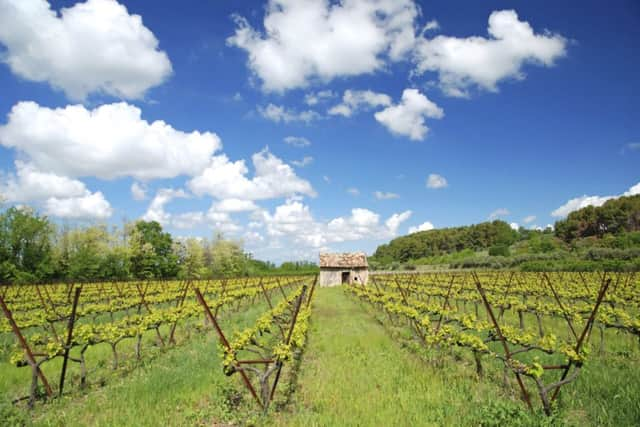Travel: The best of both worlds in Alsace


Gewürztraminer has long been a favourite wine. At its best it is deeply layered and slightly spicy and is excellent company, to my taste, for chicken cooked with butter and tarragon. Yet Alsace, which probably produces more of it than any other wine region in the world, had somehow eluded me. I had driven through it, even stopped to buy a few bottles, but had never explored it.
Superficial observation during a trip there this summer suggested I’m far from alone. This is not one of those areas of France seemingly colonised by the British. The name of the wine, or to be precise, the grape variety from which it is made, may provide a clue: the umlaut over the u, the z pronounced as ts, is German rather than French. Then there’s what you might call the Alsatian regional dish, choucroute garnie, which is sauerkraut, usually with sausage, ham and pork. It doesn’t conjure images of that cricket-buzzing, somnolent, rural France that fills the memory of so many summer holidays.
Advertisement
Hide AdAdvertisement
Hide AdBut Alsace, despite the incursion of German pronunciation and cuisine and the yearning of some for independence, remains resolutely French. That’s not so surprising when you consider it was twice annexed by Germany in 80 years and that, on the second occasion, the locals were obliged to speak German and change their names from French. Here and there you will find a war memorial which remembers those forcibly conscripted by the Nazis to fight, as that in the village of Riquewihr reminds you, for a cause reviled.
Germany lies just across a broad, flat, alluvial plain where the Rhine serves as the frontier. The uplands of the Black Forest colour the horizon. On the French side waves of vines wash softly against the lower slopes of the forested Vosges Mountains. Among the vineyards, like jewels on green cushions, sit so many lovely villages and small towns, full of half-timbered buildings, Renaissance bay windows, vivid overflowing window boxes and chimneys topped with storks’ nests that you risk overdosing on the picturesqueness of it all.
CONNECT WITH THE SCOTSMAN
• Subscribe to our daily newsletter (requires registration) and get the latest news, sport and business headlines delivered to your inbox every morning
We stayed first in Itterswiller, at the lovely Hotel Arnold, in a room with a terrace which overlooked ranked vines growing only feet away. Vines had been trained to form arches across the main street. There was no boulangerie or anywhere else to buy standard provisions in the village but I lost count of the number of wine “caves”. In the gorgeous little town of Barr, a short drive away, we bought a picnic and maps and climbed high above the rust-coloured rooftops to Landsberg Castle, built originally in the 12th century, destroyed in the 30 Years War, now a wonderfully Gothic, ivy-clad ruin.
On a gloriously sunny morning we walked through vineyards to Andlau, seat of a great abbey founded by Charlemagne’s wife in the 9th century. An attempt to hike from Kaysersberg, with its ancient fortified bridge, to Riquewihr foundered when we took the wrong path but, like most of the prettiest villages, they are only a short distance by road. So having abandoned the walk there was still time to join the tourist throng on Riquewihr’s impressive Grand’Rue.
A day was set aside for the beautiful regional capital, Colmar, where powered punts laden with tourists glide along narrow waterways in Petite Venise (Little Venice), principally to see the 16th-century Isenheim altarpiece. Usually in the Unterlinden Museum but temporarily in the town’s Dominican Church, this polyptych is one of Europe’s great treasures of devotional art. Painted by Matthias Grünewald, with sculpture by Niclaus of Hagenau, it was commissioned for the hospital chapel of St Anthony’s Monastery at Isenheim, not far away. The monks there specialised in treating St Anthony’s fire, a sickness caused by eating bread made of infected grain, which explains the harrowing appearance of Christ’s flesh. Grünewald’s masterpiece illustrates the power of religious art to warn and educate with extraordinary clarity.
The temperature soared to 36.5C – exceptional for Alsace but worth noting, to dispel any notions of gloomy weather as a deterrent. It was far too hot to walk at low level, so we drove up to the Col de la Schlucht – a pass at 1,129 metres – and struck out through woodland and along an airy ridge above steep green amphitheatres scooped by ice glaciers.
There was excellent eating wherever we went. We didn’t get around to the ubiquitous choucroute, but German influences inevitably crept in. This was the asparagus season, celebrated here as it is across the border, so we gorged on large portions – it’s invariably cultivated white rather than green and often served with ham.
Advertisement
Hide AdAdvertisement
Hide AdOne night for pudding there was Kougelhopf, a cake with a hole in the centre, soaked in rum and topped with crème fraîche.
As photogenic aspects became less of a novelty the camera came out less and less. But after dark in the village of Eguisheim, we realised we were not quite blasé yet. Strolling back to our hotel after dinner, along a cobbled, traffic-free street lined with centuries-old buildings, we were struck by the thought – clichéd but unavoidable – that we had slipped back to a past age.
I celebrated my birthday in Alsace, not with the usual coupe of champagne but with Crémant d’Alsace, the local fizz. I left feeling that while many happy returns might be an exaggeration, there would certainly be several.
• The quickest route to Alsace is via Basel-Mulhouse-Freiburg Airport, which is about 40 minutes’ drive from Colmar. EasyJet (www.easyjet.com) flies to the airport from Edinburgh.
SCOTSMAN TABLET AND IPHONE APPS